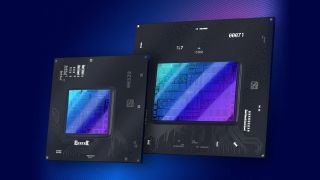Intel wants a piece of the $1,000 GPU market, targeting the ultra-enthusiast segment with Celestial
Intel is also promising "discrete graphics class performance with the efficiency of integrated graphics" next year.

Intel is already hard at work on the successors to its Alchemist graphics cards, the GPUs set to ship in their millions from April this year. Those successors, Battlemage and Celestial, promise a lot, that much we can glean from the scant lines they have been afforded in Intel's latest Investor Meeting today.
Battlemage offers "discrete graphics class performance with the efficiency of integrated graphics" and it's calling Celestial a graphics card lineup that will "address the ultra-enthusiast segment." And that is something its first and second-gen GPUs are most definitely not.
The Alchemist chips landing this year are designed to be competitive, to offer GPU performance on par with the middle order of the competing silicon already released by AMD and Nvidia in their respective Radeon RX 6000 and GeForce RTX 30-series guises. Reports are that we ought to be looking around RTX 3070 Ti levels of performance.
Which will be great if it truly can ship "more than 4 million discrete GPUs in 2022" as promised. In a mire of a graphics card crisis, we don't need Intel to turn up with the fastest GPU in the world, we just need them to be competitive and affordable. And, well to exist in numbers that mean we can actually buy one. Then Intel might genuinely be able to offer a way out of this mess.
What Alchemist isn't going to do is offer us gaming performance that will stand toe-to-toe with the AMD RX 6900 XT or Nvidia RTX 3090. Those ultra-enthusiast cards are out of reach for the first generation of Intel's discrete GPU venture.
The third Arc generation, Celestial, however, is going to be aiming its high-end sights very firmly on that market. Or so Intel is telling its investors.

"Architecture work has begun on Celestial, a product that will address the ultra-enthusiast segment," reads the release with Raja Koduri following up in his breakout session, promising performance leadership.
The biggest gaming news, reviews and hardware deals
Keep up to date with the most important stories and the best deals, as picked by the PC Gamer team.
But what about Battlemage, you say? Well, okay, you probably didn't because what the hell kind of naming scheme is this, Intel? Anyway, Battlemage is the second generation of Intel graphics cards, and is set to arrive next year alongside its Meteor Lake processors.
And holy crap it sounds awesome and promises to stretch up to the sort of enthusiast-class GPU segment the RTX 3080 and RX 6800 XT inhabit today.
"Over the next two years, with Battlemage as well as Meteor Lake, we will cover additional market segments, reaching all the way into enthusiast class GPUs," says Intel's Raja Koduri.
"Meteor Lake is a brand new architecture that will enable tiled GPUs to be integrated onto a 3D package. This is super exciting. This allows us to offer discrete graphics class performance with the efficiency of integrated graphics."
Yes, you read that right. Intel is promising discrete GPU performance in your next CPU. I mean, we've heard that before, but Raja looks super serious this time.
"This is a new class of graphics, you can't really call it integrated or discrete," he says with a chuckle. So, not super serious.

How to buy a graphics card: tips on buying a graphics card in the barren silicon landscape that is 2022
"And this is just the beginning of the strategic advantages that this tiled architecture will give us. We are already working on our Celestial architecture with the goal of performance leadership in every segment we participate in. From low power mobile to high performance workstations."
Intel's first generation of graphics cards has still yet to ship in earnest, though we are promised a bit of a glut by all accounts. Whether this is Intel forstalling any concerns about Alchemist's performance I'm not sure, but it's keen to point out that it is most definitely chasing the high end of PC graphics cards for its next generation of GPUs.
And aiming to lead the pack in 2024. That's a hella ambitious goal, Intel, but why not shoot for the moon, eh?

Dave has been gaming since the days of Zaxxon and Lady Bug on the Colecovision, and code books for the Commodore Vic 20 (Death Race 2000!). He built his first gaming PC at the tender age of 16, and finally finished bug-fixing the Cyrix-based system around a year later. When he dropped it out of the window. He first started writing for Official PlayStation Magazine and Xbox World many decades ago, then moved onto PC Format full-time, then PC Gamer, TechRadar, and T3 among others. Now he's back, writing about the nightmarish graphics card market, CPUs with more cores than sense, gaming laptops hotter than the sun, and SSDs more capacious than a Cybertruck.
Most Popular






